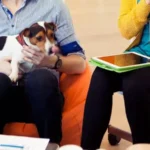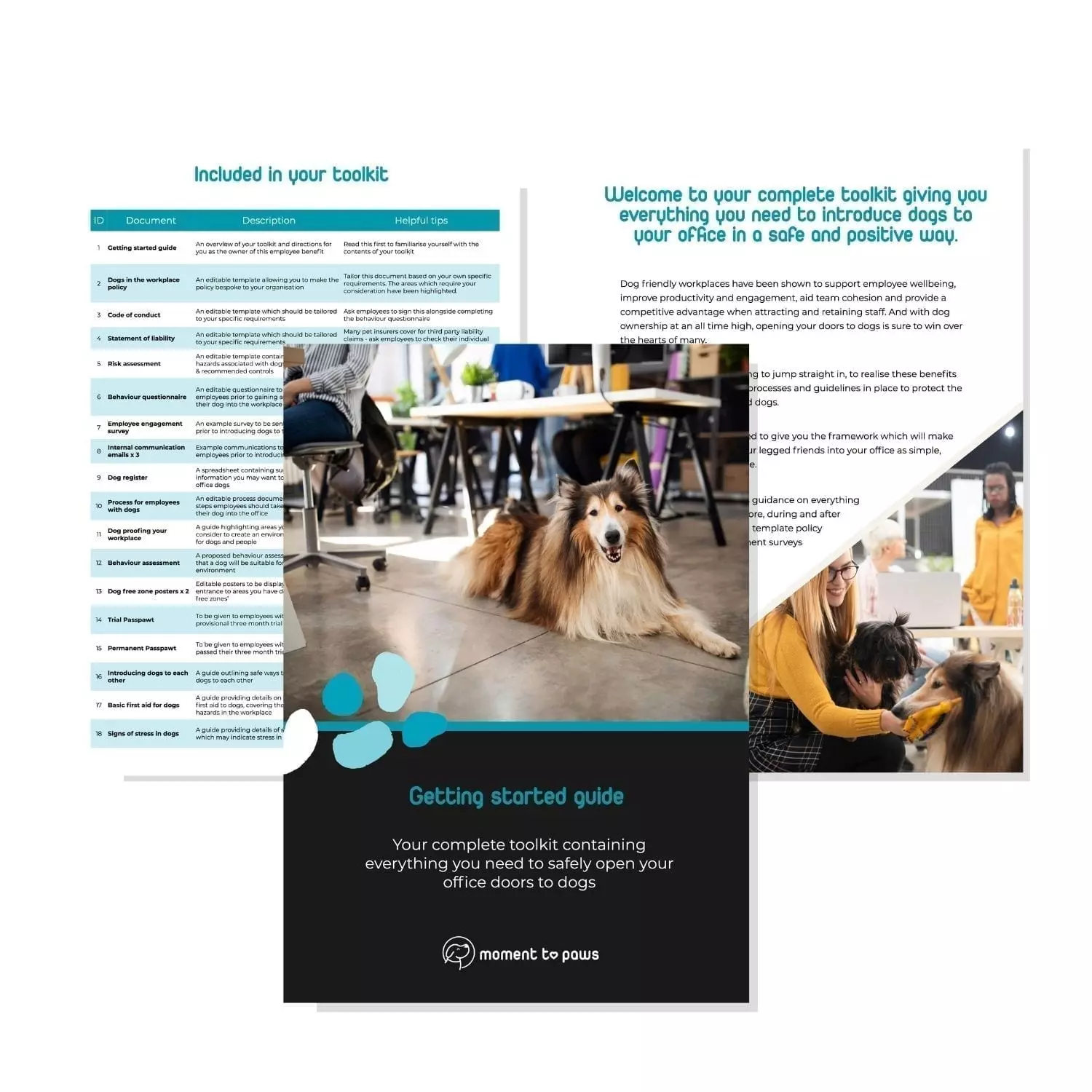
Top ten benefits that dogs can bring to your workplace
19 January 2021
The top dog friendly companies leading the way across the UK
8 May 2021How to train your dog to behave well in the office
All around the country, our dogs are lapping up lockdown. The constant presence of their human really is enough to make them think that all their dream’s have come true. So what happens when your office reopens?
If you’re one of the lucky ones, you work for an organisation which recognises the value that dogs can bring to the workplace (if you’re not, you might want to point your employer in the direction of this article).
But while you might be excited at the prospect of introducing your four legged friend to your colleagues, there may be another part of you wondering how your dog will behave in the office environment, particularly if they were a lockdown puppy and haven’t had exposure to as many new experiences as you would have liked.
Here we share our tops tips that you can train at home to get your dog ready to join you in the office.
1. Nail down basic commands
It goes without saying that before you even consider taking your dog into the office, they need to be trained to understand basic commands such as sit, stay and come. Work on this at home – both inside and outdoors where there are distractions – until they are listening to you 100% of the time.
2. When they’re around you, good things happen
Make sure your pup knows that staying close to you is the best place to be! Begin in your home with a handful of biscuits. Encourage your dog to come to your side, say your reward word or press your clicker and give them with a treat. You may want to assign a command to this behaviour such as ‘heel’. Now take a step forward, encouraging them to step with you and again, reward with your word or click and treat. Continue this process, gradually building up the number of steps you can take while your dog remains at your side.
Once your dog is consistently remaining by your side indoors when you ask them to heel, take the training outdoors where there are slightly more distractions. Repeat the same process. If you find that your dog is too distracted to listen, try to find somewhere that’s less of a jump from the home environment and build it up more gradually.
It’s worth noting that in cases where your dog is distracted and not paying attention, a higher motivation lies elsewhere e.g. the prospect of saying hello to another dog becomes more enticing than the prospect of a treat from you. Therefore we need to readdress the motivation hierarchy (e.g. by changing the reward to something more desirable) or use the Premack Principle which we will talk about in the next top tip.
3. Get your dog into the habit of check ins
Teaching your dog to ‘check in’ with you is a simple yet powerful technique that will help in every area of your training. Check in is simply another way to ask your dog to look in your direction or get their attention.
One way to teach this is through the Premack Principle. This is where a more probable behaviour (what your dog wants to do) reinforces a less probable behaviour (what you want your dog to do). A simple way to start teaching this is when giving your dog food. What your dog wants is the food…but you want your dog to give you eye contact first. When you begin training, as soon as your dog looks away from the food and to you, put the food down. This will start the reinforcement process. Gradually your dog will learn that giving you eye contact (the less probable behaviour) means they get to eat their food (the more probable behaviour). You may want to add a command such as ‘look’.
Now let’s apply this to the office environment where there may be other dogs around. Naturally your dog may want to go and greet other dogs (the more probable behaviour). You, on the other hand, would like your dog to stay with you until you’ve checked with the other dog owner that it’s okay (the less probable behaviour). If your dog has been taught that giving you eye contact and waiting for you to give them the green light gets them what they want, it will be much easier to control this situation.
4. Get comfortable around other dogs
It’s an unfortunate truth that many ‘lockdown puppies’ won’t have been able to socialise as much as we’d like. Before considering taking your dog to the office with other dogs, it’s essential that they’ve been given the opportunity to be indoors with another dog. The indoor environment is very different to playing outdoors in the park so don’t assume that because they’re okay with others outdoors, they’ll automatically be okay indoors.
5. Create a safe space
It’s important that your dog is able to relax when not given attention so that you can get on with your work. Teach them that ‘bed’ or ‘mat’ is where they can relax and sleep. Initially, you can begin by showing them that when they sit on their bed or mat, good things happen e.g. they get a treat or their favourite toy. This means when you transfer the bed or mat to the office, they’ll know this is their safe space.
By investing time in your training while working from home, it will help to make the transition into the office easier. But please remember, not every dog is suited to the office environment so it’s essential that you keep an eye out for any indications that they might be experiencing stress. Take a look at our top signs of stress article to make sure you know what to look out for.

Your complete guide to a dog friendly office
3. Get your dog into the habit of check ins
Teaching your dog to ‘check in’ with you is a simple yet powerful technique that will help in every area of your training. Check in is simply another way to ask your dog to look in your direction or get their attention.
One way to teach this is through the Premack Principle. This is where a more probable behaviour (what your dog wants to do) reinforces a less probable behaviour (what you want your dog to do). A simple way to start teaching this is when giving your dog food. What your dog wants is the food…but you want your dog to give you eye contact first. When you begin training, as soon as your dog looks away from the food and to you, put the food down. This will start the reinforcement process. Gradually your dog will learn that giving you eye contact (the less probable behaviour) means they get to eat their food (the more probable behaviour). You may want to add a command such as ‘look’.
Now let’s apply this to the office environment where there may be other dogs around. Naturally your dog may want to go and greet other dogs (the more probable behaviour). You, on the other hand, would like your dog to stay with you until you’ve checked with the other dog owner that it’s okay (the less probable behaviour). If your dog has been taught that giving you eye contact and waiting for you to give them the green light gets them what they want, it will be much easier to control this situation.
4. Get comfortable around other dogs
It’s an unfortunate truth that many ‘lockdown puppies’ won’t have been able to socialise as much as we’d like. Before considering taking your dog to the office with other dogs, it’s essential that they’ve been given the opportunity to be indoors with another dog. The indoor environment is very different to playing outdoors in the park so don’t assume that because they’re okay with others outdoors, they’ll automatically be okay indoors.
5. Create a safe space
It’s important that your dog is able to relax when not given attention so that you can get on with your work. Teach them that ‘bed’ or ‘mat’ is where they can relax and sleep. Initially, you can begin by showing them that when they sit on their bed or mat, good things happen e.g. they get a treat or their favourite toy. This means when you transfer the bed or mat to the office, they’ll know this is their safe space.
By investing time in your training while working from home, it will help to make the transition into the office easier. But please remember, not every dog is suited to the office environment so it’s essential that you keep an eye out for any indications that they might be experiencing stress. Take a look at our top signs of stress article to make sure you know what to look out for.







